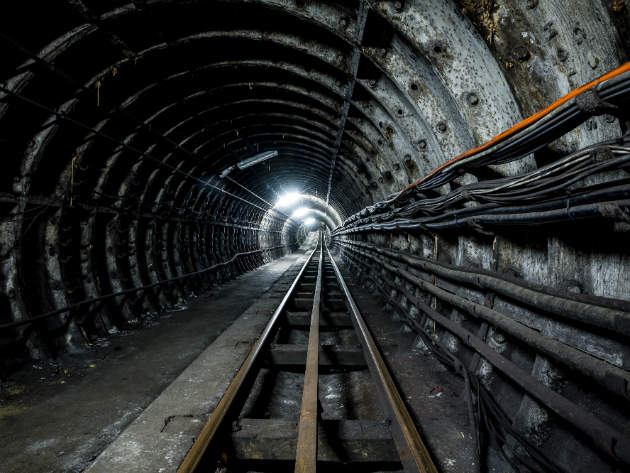
This summer, a new museum celebrating the UK Post Office opened its doors to the public. As part of this, an abandoned and forgotten underground railway that transported post under the streets of London from 1927 to 2003, has been reopened.
In 1927, a new underground rail line opened in London. This, however, did not transport passengers. Instead, it was overflowing with post.
At its height, the Post Office railway, known as Mail Rail, carried more than four million letters a day, employed over 220 staff and operated for 22 hours a day. It served as the connection between people, linking millions through the art of letters. It could be described as a predecessor to modern-day social networks.
The narrow tunnels of Mail Rail, which run for 6.5 miles from Whitechapel in east London to Paddington, slashed the journey time across the capital and became the beating heart of the Post Office. It was ahead of its time, too, using driverless electric trains.
However, come 2003 it was deemed no longer viable so ceased operations. Over the next decade or so its story was lost, until 2013 when tentative hopes of reopening part of the network as a visitor attraction emerged. Plans were approved in 2014, followed by a test drive through a section of the tunnels last December.
On 4 September, Mail Rail will open its doors to the public for the first time. “We hoped [to open] earlier,” says Harry Huskisson, head of communications and marketing at the Postal Museum (more on that later), during a press tour in July. “We’re going into these 100-year-old tunnels, installing bespoke systems to create a visitor attraction, so it comes with a lot of challenges.”

US Tariffs are shifting - will you react or anticipate?
Don’t let policy changes catch you off guard. Stay proactive with real-time data and expert analysis.
By GlobalDataThe post: ‘a social story’
The question of why now is the right time for Mail Rail to become part of London’s tourist attractions is two-fold: opportunity and history. “Mail Rail affords people a once in a lifetime opportunity to explore a slice of subterranean London, previously hidden from public view,” says Adrian Steel, director of the Postal Museum.
Curiosity is a powerful motivator. “It’s a social story,” explains Chris Taft, head of collections at the Postal Museum. “It is about the communication. We talk about it being the first social network.
“We’ve tried to keep as much of the original infrastructure as possible,” explains Huskisson. “Working down here were the electricians, the engineers, everyone who had a role to play on the Mail Rail. It was a real battleship mentality.”
One of the more striking aspects of the twenty-minute ride is that this is not just about the physical aspect of taking a journey; it’s about understanding the history and people who worked on the railway. As Huskisson says: “We want the exhibition to tell their story, too. This is isn’t just about the engineering marvel of Mail Rail or railways.”
Mail Rail’s origins can be traced back to 1855, when Rowland Hill, the then secretary to the Post Office, unveiled plans for a system to transport mail in underground tubes. After several iterations, and many years later, the Post Office (London) Railway Bill was passed in 1913, with construction starting the following year. The First World War and the subsequent high price of materials meant that the opening of Mail Rail was delayed until 5 December, 1927. From then on, it more than proved its worth, keeping post moving through World War II and the ensuing decades.
Audio visual displays, projected onto the walls of the tunnels, also showcase the story of Mail Rail through the decades. At predetermined intervals, the ride stops and images light up the darkness. An audio recording also gives visitors extra information. “The railway had to be fitted out, which was a hugely complex task, really,” says Taft. “It was designed to carry the post, not people, so it was a huge undertaking to make it viable.”
Don’t forget the museum
As mentioned, Mail Rail is just one part of the new Postal Museum, which opened on Friday 28 July. The museum spans five centuries of postal history and “you’ll see some quirky objects”, says Huskisson. “You’ll also go into the post during conflict, which covers World War I, World War II and also things like the Troubles in Northern Ireland.
“Then it’s the design part of the gallery, which is all about the heyday of the Post Office and the change from text-based posters to photography and the commissioning of films to [promote] the services of the Post Office. That also touches on the Post Office’s film unit being used for propaganda films by the government during World War II.”
There’s also a rather enjoyable Travelling Post Office train carriage in which people can attempt to sort letters while the floor wobbles, numerous galleries and exhibitions, and a chance to create personalised stamps. Taft says it shows “how wide-ranging the postal service was” – it isn’t just about stamps and letter boxes. He adds: “It was a couple of years’ worth of design work. There’s a whole building here, with discovery rooms, research materials, a learning space for schools, and obviously office space.”
There are two stories being told: one, the engineering feat of Mail Rail (a likely draw for railway enthusiasts), and two, the history of letters, stamps, and so on, which is music to the ears of those with a passion for all things post-related. Discovering hitherto lost accounts of workers and the role of the Post Office during historic events in the UK’s history is central to the thinking behind this endeavour.
As the PR campaign puts it: Abandoned, secret, forgotten. Until now.



